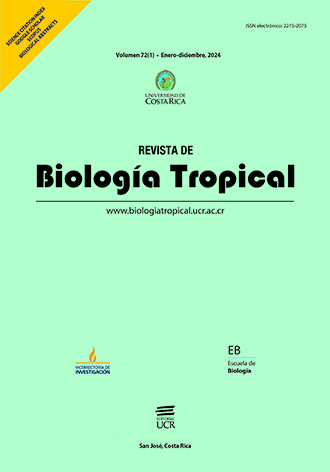Abstract
Introduction: Carollia is characterized by the challenge of identifying individuals of different species. In Panama, no investigation has been conducted on this genus’s accurate classification and identification. However, molecular and phylogenetic studies have been conducted in other regions of the Americas, demonstrating the difficulty of morphological differentiation. The taxonomic keys for identifying this genus tend to vary, making it difficult in Panamanian localities. Objective: To evaluate the external morphometric and morphological characteristics of Carollia specimens using multivariate statistical techniques to facilitate species identification. Methods: We used previous data matrices, which were updated in the field from October 2022 to January 2023 using mist nets. External morphometric measurements (tail, forearm, hand wing, tibia, calcaneus, tragus, hair colour, and body size) and individual characteristics were recorded. 263 specimens of the four species reported for Panama were recorded. We used univariate statistics to compare each of these characteristics between species. Multivariate analyses, such as principal component analysis (PCA), linear discriminant analysis (LDA), quadratic discriminant analysis (QDA), and partial least square discriminant analysis (PLS-DA) were then performed to identify the species based on external morphological and morphometric characteristics. Decision trees were also used for species classification. Results: Linear discriminant analysis (LDA) and decision trees proved to be the best option for classifying the species with up to 99 % efficiency. The most relevant characters for such classifications are the length of the tail and forearm. Conclusion: Morphometric characteristics alone do not provide adequate species discrimination. However, by analysing the parameters using multivariate models, the accuracy of the discriminatory capacity is significantly improved.
References
Basantes-Garcés, M. (2018). Caracterización morfológica y morfométrica del murciélago de orejas redondas de cabeza rayada Tonatia saurophila (Phyllostomidae: Chiroptera). [Tesis de Licenciatura, Pontificia Universidad Católica del Ecuador]. Repositorio Pontificia Universidad Católica del Ecuador. https://repositorio.puce.edu.ec/handle/123456789/20684
Bracamonte, J. C. (2018). Protocolo de muestreo para la estimación de la diversidad de murciélagos con redes de niebla en estudios de ecología. Ecología Austral, 28(2), 446–454. https://doi.org/10.25260/EA.18.28.2.0.272
Chaves, J. G. (1985). Morfometría y sistemática de murciélagos del género Carollia Gray, 1838 (Phyllostomidae, Carolliinae). [Tesis de Licenciatura no publicada]. Universidad Nacional de Colombia.
Chong, J., Yamamoto, M., & Xia, J. (2019). MetaboAnalystR 2.0: From Raw Spectra to Biological Insights. Metabolites, 9(3), 57. https://doi.org/10.3390/metabo9030057
Cuartas, C., Muñoz, J., & González, M. (2001). Una nueva especie de Carollia, Gray, 1838 (Chiroptera: Phyllostomidae) de Colombia. Revista Actualidades Biológicas, 23(75), 63–73. https://doi.org/10.17533/udea.acbi.329609
Díaz, M. M., Solari, S., Gregorin, R., Aguirre, L. F., & Barquez, R. M. (2021). Clave de Identificación de los murciélagos Neotropicales. Programa de Conservación de los Murciélagos de Argentina.
Jiménez-Ortega, A. (2013). Conocimiento y conservación de los murciélagos Filostómidos (Chiroptera: Phyllostomidae) y su utilidad como bioindicadores de la perturbación de los bosques neotropicales. [Tesis Doctoral, Universidad Autónoma de Madrid]. Repositorio Biblios-e Archivo: Repositorio Institucional de la UAM . http://hdl.handle.net/10486/660180
Jones, G., Jacobs, D. S., Kunz, T. H., Willig, M. R., & Racey, P. A. (2009). Carpe noctem: the importance of bats as bioindicators. Endangered Species Research, 8, 93–115. https://doi.org/10.3354/esr00182
Kuhn, M. (2008). Building Predictive Models in R Using the caret Package. Journal of Statistical Software, 28(5), 1–26. https://doi.org/10.18637/jss.v028.i05
Lê, S., Josse, J., & Husson, F. (2008). FactoMineR: An R Package for Multivariate Analysis. Journal of Statistical Software, 25(1), 1–18. https://doi.org/10.18637/jss.v025.i01
Muñoz, J., Cuartas-Calle, C. A., & Gonzalez, M. (2004). Se describe una nueva especie de murciélago del género Carollia Gray, 1838 (Chiroptera: Phyllostomidae) de Colombia. Actualidades Biológicas, 26(80), 80–90. https://doi.org/10.17533/udea.acbi.329461
Murillo-García, O. (2014). Short-tailed bats (Carollia: Phyllostomidae) from Gorgona National Natural Park (Colombia) and its biogeographical implications. Revista de Biología Tropical, 62(S1), 435–445. https://doi.org/10.15517/rbt.v62i0.16370
Pabón, F., & Acevedo, A. (2020). Differences In body mass among the frugivorous bats Artibeus lituratus and Carollia perspicillata (Chiroptera: Phyllostomidae) from an urban and a peri-urban area of Cúcuta, Colombia. Mammalogy Notes, 6(2),163. https://doi.org/10.47603/mano.v6n2.163.
Palacio, F. X., Apodaca, M. J., & Crisci, J. V. (2020). Análisis multivariado para datos biológicos: Teoría y su aplicación utilizando el lenguaje R (1a ed). Fundación de Historia Natural Félix de Azara.
Pine, R. (1972) The bats of the genus Carollia Texas Agricultural Experiment Station. Technical Monograph, 8, 1–125.
Reid, F. A. (2009). A field guide to the mammals of Central America & Southeast Mexico (2nd ed). Oxford University Press.
Ruelas, D., & López, E. (2017). Análisis morfogeométrico de las especies peruanas de Carollia (Chiroptera: Phyllostomidae). Mastozoología Neotropical, 25(2), 419–438. https://doi.org/10.31687/saremMN.18.25.2.0.03
Salgado-Mejia, F., López-Wilchis, R., Guevara-Chumacero, L. M., Valverde-Padilla, P. L., Martínez del Río, P. C., Porto-Ramírez, S. L., Rojas-Martínez, I., & Sámano-Barbosa, G. A. (2021). Characterization of assemblages in neotropical cave dwelling bats based on their diet, wing morphology, and flight performance. Therya, 12(3), 435–447. https://doi.org/10.12933/therya-21-1075
Solari, S., & Baker, R. J. (2006). Mithochondrial DNA Sequence, Karyotypic, and Morphologic Variation in the Carollia castanea Species Complex (Chiroptera: Phyllostomidae) with Description of a New Species. Occasional Papers. Museum of Texas Tech University, (254), 1–16. https://doi.org/10.5962/bhl.title.156889
Timm, R. M., Laval, R. K., & Rodríguez, H. (1999). Clave de campo para los murciélagos de Costa Rica. Brenesia, 52, 1–32.
Wickham, H. (2016). ggplot2: Elegant Graphics for Data Analysis (2nd ed.). Springer International Publishing.
Wilson, D. E., & Mittermeier, R. A. (Eds.). (2019). Handbook of the mammals of the world (Vol. 9). Lynx Editions.
York, H. A., Rodríguez-Herrera, B., Laval, R. K., Timm, R. M., & Lindsay, K. E. (2019). Field key to the bats of Costa Rica and Nicaragua. Journal of Mammalogy, 100(6), 1726–1749. https://doi.org/10.1093/jmammal/gyz150
Zurc, D., & Velazco, P. M. (2010). Análisis morfológico y morfométrico de Carollia colombiana Cuartas et al., 2001 y C. monohernandezi Muñoz et al., 2004 (Phyllostomidae: Carollinae) en Colombia. Chiroptera Neotropical, 16(1), 567–572.
##plugins.facebook.comentarios##

This work is licensed under a Creative Commons Attribution 4.0 International License.
Copyright (c) 2024 Revista de Biología Tropical







